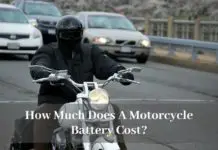
Knowing how to test or check on your motorcycle battery is a must for all motorcycle owners. Why is this so? This is because at the end of the day, having a good battery is for your own safety.
We would never wish for our motorcycles to go dead on us while we are having a fun ride with friends. Also, should we ever find ourselves in such a situation, We would want a quick out. Doing a simple test on our battery would help us be on our merry way.
So how do we test a motorcycle battery? The most essential equipment to have in order to perform this activity is a multimeter. You can either use a Digital Volt and Ohm Meter or an analog one depending on your preference. You can either perform a Static Voltage Test or a Load Test.
It is advisable that you conduct such tests on your motorcycle battery on a monthly basis to avoid headaches in the future — more information about Static Voltage Test and Load Test below.
Precaution Before Checking Your Motorcycle Battery
Prior to doing any of the instructions stated in this article, please be reminded of some safety precautions. Protect your hands using rubber gloves and your eyes with eye goggles.
Make sure that your work area is bright and the air is circulating well as gas from the battery can cause an explosion. If you are inside a garage, better bring your motorcycle out of the garage. Keep the workplace clean and children and pets away.
What Is A Mutlimeter And How Does It Work?
Since the star of this article is a multimeter, let us also quickly introduce the multimeter.
A multimeter, also known as multitester is an electronic measuring device used to measure resistance, current, and voltage. It can be an analog multimeter or a digital multimeter.
Both multimeters have the following parts:
• Display – Where voltage, current or resistance measurements can be viewed.
• Dial or Rotary Switch – Rotate and point to the measurement values required.
• Input Jacks – Where the Test leads are connected.
• Test Leads – Red and Black wires with lead tips. Used as the conductor from the equipment being measured to the multimeter.
Most prefer to use digital multimeter because it is easier to use and read as it already has a numeric display. Analog multimeter typically has a galvanometer needle display and requires a bit more effort to read especially for those none technical users.
Here are the steps before, during and after the battery test:
Step 1: Isolate The Issue
Check and ensure what type of problem your motorcycle has as it can be a wiring problem, mechanical problem or battery problem.
Some motorcycles now have some built-in safety features such as the sidestand switch wherein it will not start if the stand is up and the clutch switch that prevents the motorcycle from starting up if the clutch is engaged.
Aside from these built-in safety features, also check if the motorcycle still has fuel or if the fuel tank is just clogged. Shake your motorcycle gently and listen for a sloshing sound. Check on the exhaust as it might be blocked or the spark plug might have come loose.
Also, conduct a physical test on your battery by merely taking a look at it. Check if there is a bulge, bump or crack. See if there are any leakage and discoloration.
Step 2: Arrive At A Conclusion
Once you are done isolating where the issue lies and is able to conclude that it is indeed a battery issue, you can now proceed to test the battery.
Step 3: Test The Battery
You might have heard your mechanics say “no crank” or “no start.” Please note that they are not the same. When you hear your mechanic say “no crank,” your mechanic is indirectly saying there might be a problem with your battery. Should you hear “no start,” it might be caused by other things such as fuel or mechanical issues.
The quickest way to test if there is an issue with your battery is to go in front of your bike and check if the headlight is weak. If it has been determined that it is indeed battery issue, proceed to do the following:
Using A Multimeter To Test Your Motorcycle Battery
Static Voltage test is easy to do since you would only need to connect the multimeter or Digital Volt and Ohm Meter to the battery. To have a more accurate reading, allow your motorcycle to sit without running for about an hour.
Step 1: Connect the black test lead to the common ground input jack labeled as “COM.”
Step 2: Connect the red test lead to the input jack marked as “V” or Volts.
Step 3: Turn the dial or rotary switch of the multimeter and point it to V. Whichever range is needed.
Step 4: Turn on the multimeter.
Step 5: Connect the positive (red) lead into the positive side of your battery circuit.
Step 6: Connect the negative (black) lead to the negative side of your battery circuit.
Proceed to record the voltage that appears on your multimeter. It is worth noting that even though you have a 12-volt battery, it does not necessarily mean that if the reading is 12 volts, it is fully charged. A fully charged battery’s reading should be around 12.73 or more.
A half charged battery would have a reading of 12.06 volts. If you get a reading of 10.50, you have a dead battery. If you get a reading of 0 volts, your battery might have short-circuited. Start charging your battery if you get a reading of 12.20 volts.
If you are interested in learning more about the voltage of a motorcycle battery, then click here to read the article.
Load Voltage Test: Another Way To Test A Motorcycle Battery!
Load Voltage test is also another way of testing the battery. You should get a reading of 9.6 volts for 30 seconds at normal speed as an indication of a good healthy battery. If the voltage suddenly drops though, it means you have a battery problem.
Step 1: Connect the black test lead to the common ground input jack labeled as “COM.”
Step 2: Connect the red test lead to the input jack marked as “V.”
Step 3: Have someone press the start button.
Step 4: Turn the dial or rotary switch of the multimeter and point it to V. Whichever range is needed.
Step 5: Turn on the multimeter.
Step 6: Connect the positive (red) lead into the positive side of your battery circuit.
Step 7: Connect the negative (black) lead to the negative side of your battery circuit. Proceed to record the voltage that appears on your multimeter.
After performing the test, you should have a pretty good idea if your battery needs to be replaced or charged. Battery replacement might be expensive, but it is better than the alternative of having to deal with a problematic battery while riding your motorcycle.
Type Of Chargers And It Requires A Battery Type To Be Re-Charged Properly
If the battery needs to be recharged, there are different chargers available in the market that you can choose from. The key to have a good healthy battery for a long time is to know what type of battery to use for what purpose.
Listed below are the different chargers available for your motorcycle battery!
Trickle Charger
Trickle chargers are actually not made to charge a battery. They are mainly used to maintain the charge of your motorcycle battery. These type of chargers are used on motorcycles that have been unused for a long time such as during the winter season.
Some riders only use their motorcycles occasionally, and this type of charger is especially important to them. You are required to check on it now and then because this does not have an auto-off feature if the battery has been fully charged.
Float Charger
A float charger functions the same way as the trickle charger as it also provides a constant current to the battery. It is also used on motorcycles that have been unused for a long time. The only difference is that they have an automatic-off feature. This enables the charger to turn off should your battery be fully charged already.
Another great feature on float chargers is that they automatically turn back on if it detects that your battery requires a charge. With float chargers, there is no need to check on the charging process regularly.
Smart Charger
With a motorcycle charger, you would need to check if the battery has been fully charged regularly. This is to prevent the battery from being overcharged which may cause irreparable damage to your battery.
Smart chargers can intelligently control the amount of charge it gives your batteries, therefore, preventing it from overcharging. With a smart charger connected, there is no need to check if your battery is already full constantly. You can leave it overnight and sleep without any worries.
Final Thoughts
A multimeter is actually a good handy tool to have and be made available at home. It is an absolute must for motorcycle owners because it is an integral part of your monthly maintenance activities for your motorcycle. Testing your motorcycle battery is a sure fire way to avoid any headaches in the future. Happy riding!





